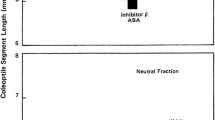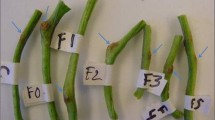Abstract
WE have been investigating the physiology of bud abscission induced by the feeding action of lygus bugs, Lygus hesperus Knight, because explants are used for biological assays1. In this bioassay, various extracts are applied in agar to the stumps of the cotyledonary petioles and the time for 50 per cent of the petioles to abscise is used for comparative purposes. In the course of these experiments in which lygus bugs were fed a water extract made from lyophilized ‘Kentucky Wonder’ green beans, Phaseolus vulgaris, we discovered that the bean extract itself contained something which would greatly accelerate abscission of the explants. Many substances are known to accelerate abscission2; especially active is the plant hormone abscisin II (ref. 3). Physiologically, however, the cotton explants react quite differently to bean extract and abscisin II. With abscisin II, no well defined separation layer is formed4 and little colour change occurs in the petioles before abscission. When the extract from 0.1 mg of dried beans was applied to each petiole, a pronounced separation layer was present after 24 h and the distal 3 mm of the petioles had turned brownish. (We used explants having petioles 6 mm long in contrast to the petioles 3 mm long used by Addicott et al.1) Abscission induced by bean extract was physiologically similar to that caused by gibberellic acid (GA3), in which a separation layer is formed accompanied by an increase in cell number5. With both GA3 and bean extract but not with abscisin II, a hyaline layer appeared in the abscission zone 12–24 h before the formation of the separation layer.
Similar content being viewed by others
References
Addicott, F. T., Carns, J. R., Lyon, J. L., Smith, O. E., and McMeans, J. L., Centre National de Recherche Scientifique, Paris, 687 (1964).
Addicott, F. T., Encyclo. Plant Physiol., 15, 1094 (1965).
Addicott, F. T., Ohkuma, K., Smith, O. E., and Thiessen, W. E., Advances in Chemical Series, 53, 97 (Amer. Chem. Soc., Washington, 1966).
Bornman, C. H., Spurr, A. R., and Addicott, F. T., Amer. J. Bot., 54, 125 (1967).
Bornman, C. H., Addicott, F. T., and Spurr, A. R., Plant Physiol., 41, 871 (1966).
Bonner, J., and English, jun., J., Plant Physiol., 13, 331 (1938).
English, J., Bonner, J., and Haagen-Smit, A. J., J. Amer. Chem. Soc., 61, 3434 (1939).
Author information
Authors and Affiliations
Rights and permissions
About this article
Cite this article
STRONG, F., KRUITWAGEN, E. Traumatic Acid : an Accelerator of Abscission in Cotton Explants. Nature 215, 1380–1381 (1967). https://doi.org/10.1038/2151380b0
Received:
Issue Date:
DOI: https://doi.org/10.1038/2151380b0
- Springer Nature Limited
This article is cited by
-
Effects of octadecanoid metabolites and inhibitors on induced nicotine accumulation inNicotiana sylvestris
Journal of Chemical Ecology (1996)
-
Fatty acid signalling in plants and their associated microorganisms
Plant Molecular Biology (1994)





